MONTESSORI PROJECT
|
Click on these dates/links, to see Susan's emails and pictures Bhutan 2008 — Main page for 2008 trip |
 |
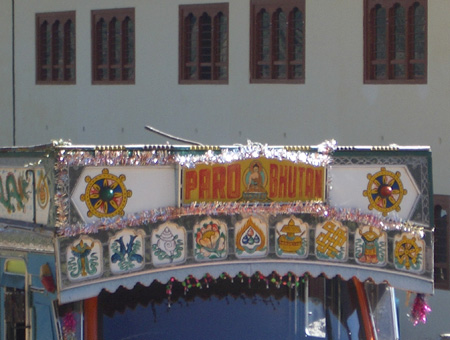 |
All work is done by hand to build the new school, and the playground. |
A close-up of the front of the truck, notice the Buddhist prayer symbols to keep it safe. |
GOOD MORNING DEARS, Last night was the end-of-research talk to the parents of Dendy's school, about bringing Montessori to Bhutan in a way that is respectful of the culture of Bhutan. I was able to talk about the practices in Bhutan that we try to teach parents in the West but that are already present here, so they will value and keep them. For example, no matter how rich or poor a family might be, there are no cribs, pacifiers, or walkers anywhere in Bhutan, and this really supports the best development for the newborn and infant! These parents were the best audience I have ever had and at the end said their eyes had been opened and their lives had been changed. I always leave time for questions and at first there were one, but once they started the people didn't even want to leave. It was very exciting. |
BHUTANESE GRACE AND COURTESY I was also able to talk about the Bhutan practices of what we call "grace and courtesy" and that are known here as "drignam lamszha" and "tadanshi" (this is probably terrible spelling so don't quote me). In Montessori we divide this subject into three categories
But before the USA was even a country the people of Bhutan had formal studies of grace and courtesy! Children learn from parents and grandparents, and young monks learn everyday in the dzong, and civil servants and high school graduates study it in classes. These lessons include the most thoughtful, graceful, and polite ways of walking, talking, dressing, greeting, handing things to another, many, many elements of thoughtfulness and good manners. |
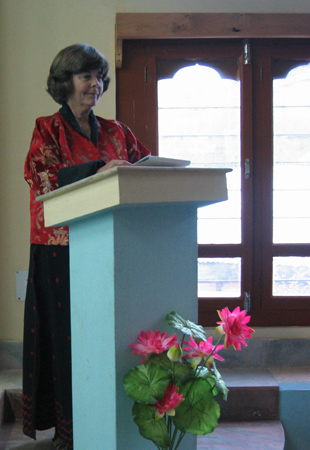 |
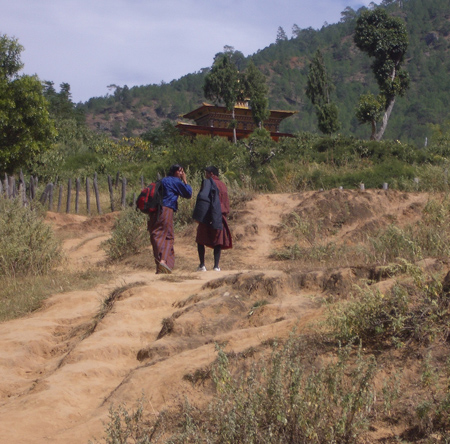 |
Susan giving a talk and showing a video on Montessori education, to the Paro parents. |
This couple has walked for 8 days to come to a special temple to pray, in hopes of having a child. |
Now, aside from helping Dendy plan the three areas of practical life for her real Montessori class to begin in February, we have two days to explore. In a few minutes we are leaving for Haa, a two hour trip, where we will have a picnic at the top of the mountain pass. But we are warned not to stay too long at the pass because even for the Bhutanese one can suffer the problems of altitude sickness for staying too long so high. I suffered greatly with this in Tibet and do not want to risk it. If you look on the map you will see that the Hass valley is the very most western one on the way to Tibet. It is necessary to drive windy roads up, up into the mountains and drive over the highest pass in the whole country accessed by a road. |
PARENTS PETITION AND GIVE THANKS FOR A CHILD One day, as we hiked up to the famous temple of Drukpa Kinley, "The Divine Madman", we met a couple who had walked from their home, walked for eight days, in order to pray for the birth of a child. Our hostess, Montessori teacher Dendy, had done the same thing before each of her children was born. It is then the custom to return to this temple once a year in order to give thanks for the child. On the day we met another couple who were on their way, with their young child, for their annual expression of thanks. |
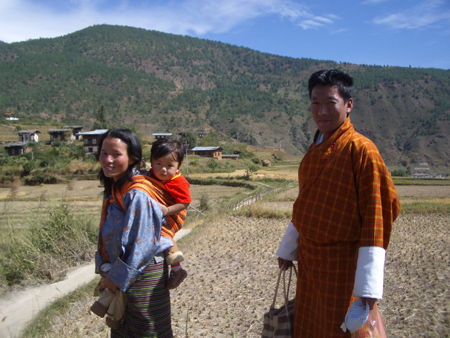 |
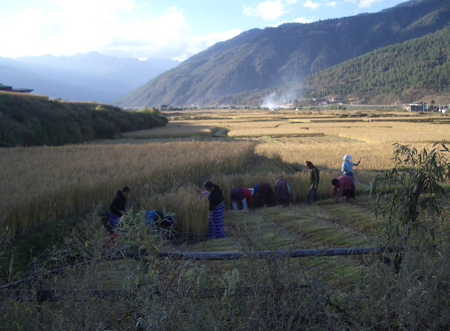 |
This couple, and their child, have returned to the same temple to give thanks for their child's birth. |
The Paro valley rice harvest is fast and furious, with lots of celebration. |
BHUTANESE FOLK BELIEFS There are many traditional beliefs here, and one should not be too quick to say that they are meaningless superstition. For example, the belief in ghosts helps to keep a crawling infant safe, in this way: as I said earlier, it is safe for an infant to crawl all over the house because of the tall door jambs between rooms that are build that way to be protected from ghosts. Even Dendy's mother's generation believes that these ghosts have a generally human shape and walk upright, but they cannot lift their feet when walking, but instead they shuffle, and so cannot get over the door jams. |
Another interesting belief is that if a rooster accidentally crows in the middle of the night it means that a spirit is roaming. If it crows a second time, the spirit is leaving. A third time the spirit is returning, a fourth and the spirit is leaving. So, in the morning if the rooster has crowed an even number of times all is well, but if it is an uneven number of times, there must be a ceremony or puja to cleanse the house. THE RICE HARVEST The rice is almost all harvested here in the Paro valley and winter is coming. Snow is visible every morning on the high peaks but often still mostly melts by evening. |
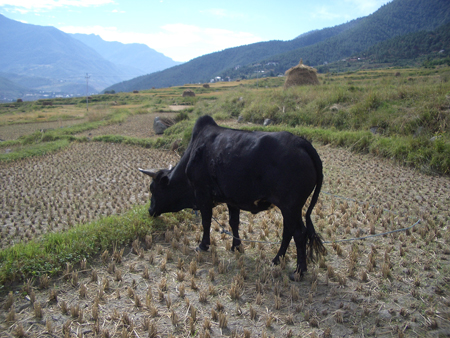 |
 |
Cattle feed themselves and make the fields neat after the harvest. |
Stopping along the road to buy fresh wild and cultivated vegetables. |
Last trip, 2006, I arrived after the rice was harvested and it is so nice to see the process this year. Friends and family gather to help cut and stack the rice, all by hand. One sees people of all ages walking in the fields and along the road with huge bundles of rice on their backs. Next the rice is separated from the chaff by throwing it up in the air, which is also done in the fields. Then it is put into bags and taken to each families farmhouse. I went with Dendy one day to get rice from her mother's farmhouse for the family back in Paro. After the harvest the cattle are turned free to eat the small bits of grain that have fallen, and the grass that separates the plots. It is not exactly legal to do this, but the best way to feed the animals. Just as one sees horses roaming through the valley and town, at this time of year the cattle abound. Like the Tibetans, Bhutanese do not like to use antibiotics which kill tiny organisms, except in rare emergencies. Did I mention that neither do they use insecticides for the same reason? That makes all food in Bhutan organic which is pretty great. In the picture above you can see us stopping to buy one of the favorite vegetable, the new, tender shoots of the ferns called "fiddleheads." No matter where we went, if there was a farmer selling fruits or vegetables along the road, we stopped. And we never went into a home without taking some as a gift. |
There is no central heating in homes or schools, just small electric heaters used for short periods of time. When a person might be coming down with a cold he will wear especially warm socks, and wool hat and gloves all day, inside or out, to help the body stay warm and fight the germs. The traditional clothing you see us wearing goes a long way to keep us warm, and it is easy wear long underwear beneath the long sleeves and the long skirts. By the way, the 2007 edition of the Lonely Planet "Bhutan" book, would be great for your research in the Montessori elementary classes now that you have had some first hand observations from a Montessori teacher. Of course it is not perfect, but one of the best resources for learning about the country of Bhutan.
|
Return to the Bhutan Montessori Project home page — Bhutan, 2006 Return to Michael Olaf Children's Projects — Projects |
|